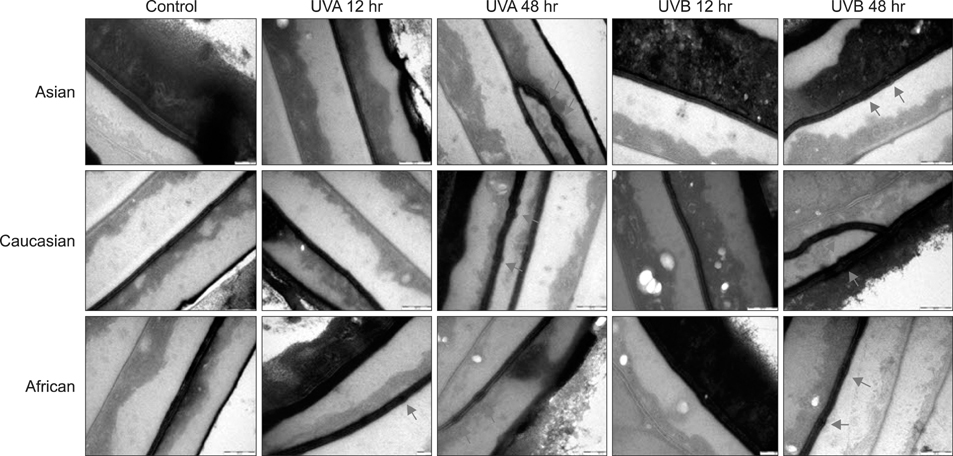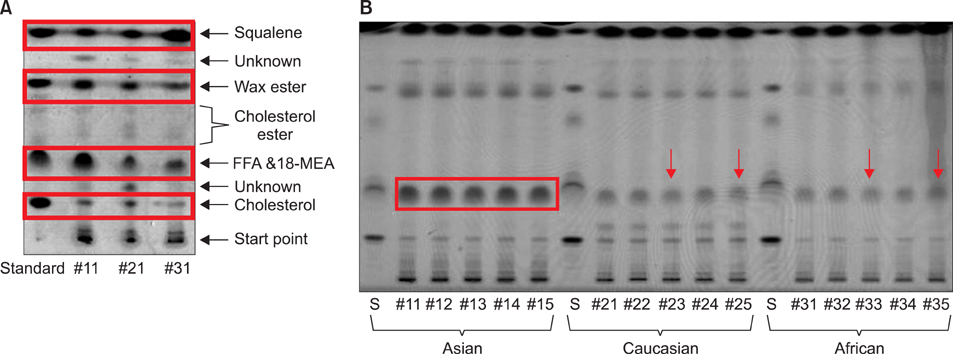Ann Dermatol.
2013 Feb;25(1):54-60. 10.5021/ad.2013.25.1.54.
The Ethnic Differences of the Damage of Hair and Integral Hair Lipid after Ultra Violet Radiation
- Affiliations
-
- 1Department of Dermatology and Institute of Hair and Cosmetic Medicine, Yonsei University Wonju College of Medicine, Wonju, Korea. leewonsoo@yonsei.ac.kr
- 2Department of Life Science, Gachon University, Seongnam, Korea.
- 3Central Research Laboratory, Aekyung Industrial Inc., Daejeon, Korea.
- KMID: 2265971
- DOI: http://doi.org/10.5021/ad.2013.25.1.54
Abstract
- BACKGROUND
Genetic factors account for the majority of differences in skin color and hair morphology across human populations. Although many studies have been conducted to examine differences in skin color across populations, few studies have examined differences in hair morphology.
OBJECTIVE
To investigate changing of integral hair lipids after ultraviolet (UV) irradiation in three human ethnic groups.
METHODS
We studied the UV irradiation induced hair damage in hairs of three human populations. UV irradiation had been performed with self-manufactured phototherapy system. Damaged hair samples were prepared at 12 and 48 hours after UVA (20 J/sec) and UVB (8 J/sec) irradiation. We evaluated the changes of hair lipid using scanning electron microscopy (SEM), transmission electron microscopy (TEM), lipid TEM and HP-TLC. After UV irradiation, hair surface damage was shown.
RESULTS
African hair showed more severe damage on hair surface than others. The lipid compositions across human populations were similar, but Asian hair had more integral hair lipids than other groups as a whole. Especially, free fatty acid contents were higher than other lipids. After UV irradiation, lipid contents were decreased. These patterns were shown in all human populations. Asian hair has more integral hair lipid than European or African hair. After UV irradiation, European and African hair samples exhibited more damage because they have less integral hair lipids. However, Asian hair samples have less damage.
CONCLUSION
We conclude that integral hair lipid may protect the hair against the UV light.
Keyword
MeSH Terms
Figure
Reference
-
1. Lee WS, Oh TH, Chun SH, Jeon SY, Lee EY, Lee S, et al. Integral lipid in human hair follicle. J Investig Dermatol Symp Proc. 2005. 10:234–237.
Article2. Wertz PW, Downing DT. Integral lipids of mammalian hair. Comp Biochem Physiol B. 1989. 92:759–761.
Article3. Jones LN, Rivett DE. The role of 18-methyleicosanoic acid in the structure and formation of mammalian hair fibres. Micron. 1997. 28:469–485.
Article4. Jeon SY, Pi LQ, Lee WS. Comparison of hair shaft damage after UVA and UVB irradiation. J Cosmet Sci. 2008. 59:151–156.5. Rook A. The clinical importance of 'weathering' in human hair. Br J Dermatol. 1976. 95:111–112.
Article6. Gao T, Bedell A. Ultraviolet damage on natural gray hair and its photoprotection. J Cosmet Sci. 2001. 52:103–118.7. Kim YD, Jeon SY, Ji JH, Lee WS. Development of a classification system for extrinsic hair damage: standard grading of electron microscopic findings of damaged hairs. Am J Dermatopathol. 2010. 32:432–438.
Article8. Ahn HJ, Lee WS. An ultrastuctural study of hair fiber damage and restoration following treatment with permanent hair dye. Int J Dermatol. 2002. 41:88–92.
Article9. Franbourg A, Hallegot P, Baltenneck F, Toutain C, Leroy F. Current research on ethnic hair. J Am Acad Dermatol. 2003. 48:S115–S119.
Article10. Dekio S, Jidoi J. Hair low-sulfur protein composition does not differ electrophoretically among different races. J Dermatol. 1988. 15:393–396.
Article11. Nappe C, Kermici M. Electrophoretic analysis of alkylated proteins of human hair from various ethnic groups. J Soc Cosmet Chem. 1989. 40:91–99.12. Syed A, Kuhajda A, Ayoub H, Ahmad K, Frank EM. African-American hair: its physical properties and differences relative to Caucasian hair. Cosmet Toilet. 1995. 110:39–48.13. Wolfram LJ. Human hair: a unique physicochemical composite. J Am Acad Dermatol. 2003. 48:S106–S114.
Article14. Orwin DF. The cytology and cytochemistry of the wool follicle. Int Rev Cytol. 1979. 60:331–374.
Article15. Wertz PW, Downing DT. Integral lipids of human hair. Lipids. 1988. 23:878–881.
Article16. Pande CM, Jachowicz J. Hair photodamage-measurement and prevention. J Soc Cosmet Chem. 1993. 44:109–122.17. Tolgyesi E. Weathering of hair. Cosmet Toilet. 1983. 98:29–33.






